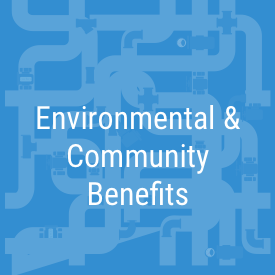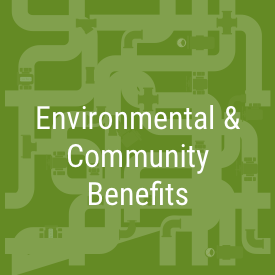The project is sponsored by the San Francisquito Creek Joint Powers Authority (SFCJPA), of which Valley Water is a member agency, in partnership with the U.S. Army Corps of Engineers (USACE). The project builds on the planning and design tasks initiated as part of the Clean, Safe Creeks plan.
Preferred project: A federal-state-local partnership
This project will complete construction of setback levees and floodwalls from San Francisco Bay to Highway 101 to provide 1% (or 100-year) flood protection and ecosystem benefits. Upstream of Highway 101 the project will provide 1% flood protection, ecosystem protection, and recreational benefits. The work upstream of Highway 101 will remedy channel constrictions and modify bridges at Newell Road and Pope/Chaucer Street, and include; a combination of: modified bridges at University Avenue and Middlefield Road; upstream detention; under-ground bypass channels; and floodwalls.
Local-state-funding-only project:
The local-state-funding-only project will be the same as the preferred project downstream of Highway 101; but upstream of Highway 101, the project will remedy channel constrictions and modify bridges at Newell Road and Pope/Chaucer Street to allow the channel to contain flood waters equal to the channel’s capacity of 7,000 cubic feet per second, approximately a 30-year event. Allowing this level of water to flow through the channel will protect approximately 3,000 parcels in Palo Alto from a flood event close to the February 1998 flood, the largest on record. Currently the channel can only convey a 15-year flood event. If sufficient funding becomes available, a 1% flood protection project upstream of Highway 101, including some combination of: modifications to the University Avenue and Middlefield Road bridges; upstream detention; underground bypass channels; and floodwalls, could be built.








Upstream of Highway 101 Reach (Upstream)
SFCJPA prepares for permit applications and Valley Water continues to work with Palo Alto ARB on Pope-Chaucer St. Bridge Replacement
The SFCJPA continues its effort in preparing applications for regulatory permits to construct the Upstream Reach of the San Francisquito Creek project. Permit applications will be submitted by the early summer of 2021 to acquire permits by the fall of 2022.
Pope-Chaucer St Bridge is currently at 80% design phase and in the Palo Alto Architectural Review Board (ARB) process. After receiving input from the ARB at its December 17, 2020 study session, the SFCJPA and Valley Water are preparing for the hearing in July 2021.
The City of Palo Alto secured additional Caltrans HBP funding for design and right-of-way acquisition for Newell Rd Bridge and construction is estimated to begin in 2023.
Previous Updates
At its September 26 meeting, the SFCJPA Board unanimously certified the San Francisquito Creek Upstream of Highway 101 Project FINAL Environmental Impact Report (EIR), approved the project, and authorized the Executive Director to secure the permits, funding and land rights necessary to build it.
This milestone follows an intense period of work to improve the Final EIR since the Draft EIR became available for public comment on April 22, 2019, and we discussed the document at several public hearings, City Council meetings, and SFCJPA Board meetings.
After receiving input from the community in 2013, the SFCJPA determined the need for a smaller scale project that addresses creek flooding similar to the 1998 flood, and that is achievable within the funding constraints of the partner agencies. Four public scoping meetings were held in January and February 2017 and the SFCJPA was tasked to develop a Draft Environmental Impact Report (Draft EIR) to evaluate the environmental impacts of each alternative.
The Draft EIR was released for public review on April 22, 2019. After considering 17 different alternatives, three alternatives advanced through the screening process: 1) Replace the Pope-Chaucer Bridge and Widen Channel Downstream, 2) Construct One or More Detention Basins, 3) Replace the Pope-Chaucer Bridge and Construct Floodwalls Downstream.
Three public hearings, in Menlo Park, East Palo Alto, and Palo Alto, were held to solicit the public’s comments on the Draft EIR.
The SFCJPA has begun the lengthy process of acquiring permits from multiple agencies to construct the Upstream Reach of the San Francisquito Creek project. Permit applications will be submitted by the spring of 2021.
The City of Palo Alto addressed City staff’s comments on the Newell Road Bridge draft EIR and the desired bridge replacement alternative. The final EIR was certified by the City Council in June 2020 with final design of the replacement bridge and permit applications to follow. For more information, visit the city’s website.
Caltrans replaced the Highway 101 bridge and frontage roads crossing over the creek to improve traffic flow and allow channel widening. The new bridges were completed in 2018.
Bay to Highway 101 Reach (Downstream)
The flood protection features of the Bay to Highway 101 Reach of the San Francisquito Creek Flood Protection Project are now complete. Improvements to this stretch of about one and a half miles of the creek constitute the necessary first step in an overall plan to provide more than 5,700 homes and businesses with creek flood protection. The project also provides improved access to trails.
Updated April 2021
Project Fact Sheets
Bay to Highway 101 (Downstream) Documents
- Final EIR (October 2012)
- Final EIR Appendices (A-C)
- Final EIR Appendices (D-F)
- See the SFCJPA Website for more documents and information
Upstream of Highway 101 Documents
Key Performance Indicators for the Safe, Clean Water Program
On June 10, 2014, the Board conducted a public hearing on the modification to the San Francisquito Creek Flood Protection Project. Below is the modified text of the preferred project with state and local funding:
The work upstream of Highway 101 would remedy channel constrictions and modify bridges at Newell Road and Pope/Chaucer Street, and include; a combination of: modified bridges at University Avenue and Middlefield Road, upstream detention, underground bypass channels, and floodwalls.
-
Preferred project with federal, state and local funding: Protect more than 3,000 parcels by providing 1% flood protection.
-
With state and local funding only: Protect approximately 3,000 parcels from flooding (100-year protection downstream of Highway 101, and approximately 30-year protection upstream of Highway 101).
Benefits
-
Provides 1% flood protection for approximately 3,000 homes and businesses in Palo Alto
-
Reduces bank erosion and sedimentation-related impacts along San Francisquito Creek
-
Provides new or improved habitats for endangered species
-
Improves water quality
-
Enhances recreational opportunities for the community
-
Leverages dollars via cost-shares and grants from the state Department of Water Resources and the California Department of Transportation
Geographic Area of Benefit
Palo Alto
Flooding History and Project Background
San Francisquito Creek is one of the last continuous riparian corridors on the San Francisco Peninsula, and is also home to 1 of the few remaining viable steelhead trout runs. The creek can cause severe flood damage with very little warning and has overflowed 7 times since 1910.
During the February 1998 El Niño event, record flooding caused an estimated $28 million in damages in Palo Alto, East Palo Alto and Menlo Park. More than 1,100 homes were flooded in Palo Alto, and Highway 101 was closed, as were numerous other roadways. The largest flood on record prior to 1998 occurred in December of 1955 when the creek overtopped its banks in several locations, inundating about 1,200 acres of commercial and residential property. Damages were estimated at nearly $2 million in 1956 dollars. Total damages from a 1% flood event are estimated at $300 million in Santa Clara and San Mateo Counties, as calculated by the USACE in 2011.
About the Safe, Clean Water and Natural Flood Protection Program
In November 2012 the voters of Santa Clara County overwhelmingly approved Measure B, the Safe, Clean Water and Natural Flood Protection Program, as a countywide special parcel tax for 15 years with a sunset date of June 30, 2028. This Program replaced the Clean, Safe Creeks and Natural Flood Protection Plan, which voters approved in November 2000.
The Safe, Clean Water Program was developed with input from more than 16,000 residents and stakeholders and was created to match the community’s needs and values. The voters of Santa Clara County identified five priorities:
Priority A: Ensure a Safe, Reliable Water Supply
Priority B: Reduce Toxins, Hazards and Contaminants in our Waterways
Priority C: Protect our Water Supply from Earthquakes and Natural Disasters
Priority D: Restore Wildlife Habitat and Provide Open Space
Priority E: Provide Flood Protection to Homes, Businesses, Schools and Highways
Other: Six projects from the Clean, Safe, Creeks Plan have been carried forward into the Safe, Clean Water Program
Each year, Valley Water prepares a report providing a progress update for each of these Program priorities, along with fiscal year accomplishments.
To ensure transparency and accountability to the voters, the ballot measure also created an Independent Monitoring Committee, appointed by the Santa Clara Valley Water District Board of Directors. The Independent Monitoring Committee annually reviews the Program’s progress to ensure the outcomes are achieved in a cost-efficient manner and reports its findings to the Board.
In addition, the Program requires three independent audits, the first of which was conducted in FY 2017.


